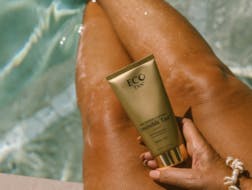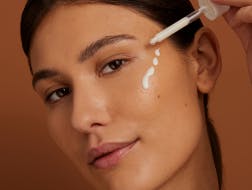What Are The Different Types Of Acne?
Blog Credit: Carla Oates | The Beauty Chef
Spots, breakouts, pimples, zits, congested skin, cystic acne, pustules, whiteheads, comedones, blackheads, nodules, cysts, papules… whatever you choose to call it—acne is a skin condition that does not discriminate.
In fact, it’s estimated that up to 85 percent of Australians will develop some form of acne during their lifetime—with 5 percent experiencing severe acne. While often we associate acne with hormonal pubescent or pre-pubescent teenagers, acne, spots, pimples and skin congestion can surface seemingly out of nowhere and can also be defined as inflammatory or non-inflammatory acne. Frustratingly too, it’s possible to experience different types of acne at the same time—and given that the underlying causes of acne can be complex to understand and diagnose effectively, it can be one of the trickiest skin conditions to treat and manage. For many, it can also be the source of embarrassment, a lack of self-confidence and endless frustration.
As a result, the skincare industry is awash with over-the-counter topical acne treatments that promise to cure acne—in all its forms. While prescription medication and topical products such as salicylic acid or benzoyl peroxide can certainly play a role in how we treat acne—especially if you're working with a dermatologist to manage a more severe form of acne—they are just one piece of the puzzle and harbour their own side effects. To maintain healthy skin and manage mild or moderate acne breakouts effectively, it’s first essential to determine its underlying causes–which can be hormonal, digestive, or a combination of both.
Unsure whether your spotty skin is due to fluctuating hormones, a badly behaved belly or both? Here’s how to spot the difference...
But First, What Is Acne?
Technically known as acne vulgaris, acne is a skin condition that manifests when there is an issue with how sebum is being produced in the skin and/or how this sebum comes to the skin’s surface. When hair follicles become clogged with dead skin cells, for example, this can trigger a buildup of excess oil/sebum and subsequently, skin inflammation.
The individual, their skin type and the type of acne they’re experiencing (inflammatory or non-inflammatory), will depend on the treatment—but what more and more research is uncovering, is that by determining the underlying causes of acne, we are subsequently better equipped to administer the most effective treatment options.
So, before rushing out to stock up on topical retinoids and creams, harsh cleansers, tinctures and tonics—it’s important to consider whether your acne is driven by hormonal changes, or perhaps, an impaired digestive system.
The Difference Between Hormonal Acne & Digestive Acne
Hormonal Acne: Exactly as it sounds, hormonal acne is caused by hormone fluctuations that essentially trigger your skin manifestations. Raised hormone levels or a sensitivity to a particular hormone, testosterone for example, are common causes as both can stimulate the skin’s sebaceous glands, contributing to an overproduction of sebum and subsequently, clogged pores at the surface of the skin. While it’s true that this common acne can surface during puberty—adult acne is also extremely prevalent amongst women throughout various stages of their menstrual cycle as their hormones shift, fluctuate and flare as oestrogen levels drop. Those who have polycystic ovarian syndrome or even women going through menopause can also experience this type of androgen-driven acne.
However, it’s not just testosterone that can contribute to hormonal acne. Cortisol—our stress hormone—also impacts our skin by dampening our immune system, disrupting the delicate balance of bacteria in our gut and directly contributing to skin inflammation—including acne.
Digestive Acne: On the flipside, digestive acne is driven more by our gut health, than our hormones. However, the link between our gut health, hormones and skin is complex as each can influence and impact the other. For example, oestrogen and progesterone (the key hormones which ebb and flow throughout a woman’s monthly cycle)—also impact how quickly food is digested and subsequently moved through the digestive tract. The gut also influences how oestrogen is metabolised and eliminated by the body. So, if we are constipated and our elimination pathways are impaired or slowed down, for example, the way our body processes oestrogen can also be disrupted and trigger hormone imbalances.
But, it’s not just the relationship between our hormones and gut health which can trigger digestive acne. There are, unfortunately, a number of gut disorders which have been linked to acne as well. SIBO—or small intestinal bacterial overgrowth—is shown to be ten times more common in people with acne while leaky gut due to stress can also be linked to the skin inflammation that is commonly experienced by those with acne. These studies indicate just how important our overall gut health is for clear, glowing skin and highlight how an imbalance in our microbiome or a condition such as leaky gut can directly impact our skin by reducing our ability to assimilate and utilise the key nutrients, vitamins and minerals that are so essential for skin health.
So, How Can I Promote More Glowing Skin?
While it’s undoubtedly important to establish the type of acne you’re experiencing—as that will assist in determining the most effective management strategy—there are certainly things you can do at home to help mitigate the effects of acne and improve your overall skin health by first turning your attention to your gut.
Rather than eliminating foods from your diet, you should instead shift your focus to replacing processed foods with more nutritious options and increasing your intake of foods that promote healthy skin—like vitamin A, E, zinc and omega-3 fatty acids. Including as many colourful vegetables in every meal is another great way to provide your body with a variety of antioxidants—which it can then draw from in order to combat free radicals which damage our health and skin. Choosing high quality low-GI and high fibre carbohydrates—such as wholegrain or seedy and sourdough breads, lentils, green veggies, legumes—over high-GI and processed sources such as white flour, pasta and white rice, will also maintain steady blood sugar levels. High fibre foods also contain prebiotics, which act as a food source for the beneficial bacteria in our gut, helping to keep them alive and thriving.
What know there are key nutrients that help to promote skin health, including vitamin C, vitamin B5, zinc and probiotics. Vitamin C, for example, is a nutrient that our body is unable to produce on its own—and therefore it’s essential we consume enough of this powerhouse vitamin through our daily diet as it plays a critical role in collagen formation and cell protection from free radical damage. Zinc is also incredibly important for strong, resilient skin as it assists with wound healing as well as skin structure and immune system function—which as we know can impact and influence the state of our skin. While you might not typically associate vitamin B5 with acne—there is building research to support its use in the treatment of acne as this complex B vitamin not only helps to reduce stress (a common trigger for acne), but it has also been shown to help reduce facial blemishes. Probiotics and fermented foods are also another simple way to improve your gut health, skin health and overall wellbeing. Studies have shown that probiotics can not only regulate and support immune function, but they also stem inflammation and can inhibit the development of pathogenic acne due to their ability to produce antibacterial proteins.
At the end of the day, no matter the type of acne you’re experiencing or the skin manifestations you’re looking to manage—improving your gut health by focusing on a nutrient-dense, fibre-rich diet that supports microbial health and diversity is the first step on the road to healthy, glowing, clear skin.


.png?ixlib=gatsbyFP&auto=compress%2Cformat&fit=max&rect=0%2C0%2C252%2C190&w=252&h=190)
.png?ixlib=gatsbyFP&auto=compress%2Cformat&fit=max&rect=68%2C0%2C663%2C500&w=252&h=190)















